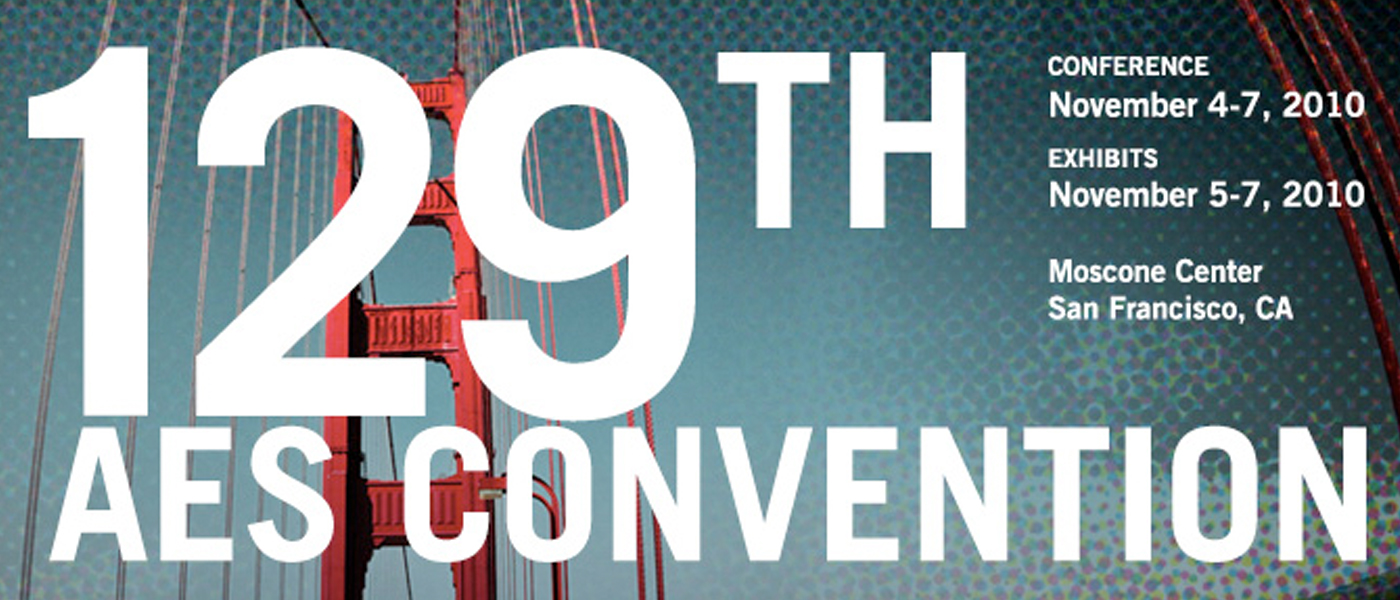
The Fourth California Audio Show was held in the San Francisco Bay area (Westin Hotel in Millbrae which is south of San Francisco), August 9, 10, and 11, 2013. Constantine Soo, the CAS4 promoter, has moved the show to the Westin this year to better accommodate the exhibitors and guests. Here is the coverage by the SECRETS team, John Johnson and Ross Jones.
Tube products were all over the place. One of the most impressive exhibits was by Raven Audio. All the preamplifiers and power amplifiers for Raven are made in Texas, USA, and the parts are point-to-point wired. Most tube products like these were from the Pacific Rim in the past years, but now we are seeing some competition from companies such as Raven, made in the USA, and they are really well built. Raven offers a huge variety of models. Following are several photos from the exhibit table in their listening room.
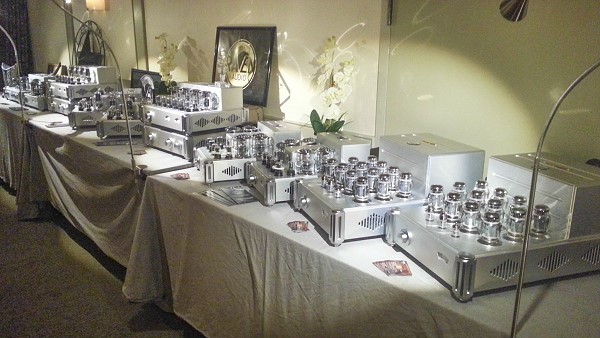
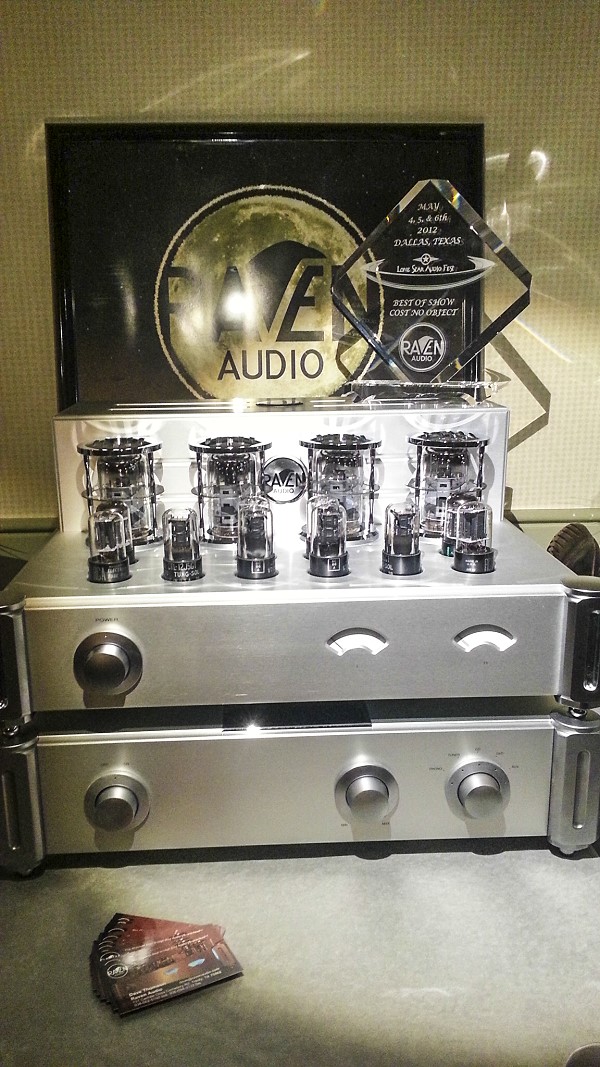
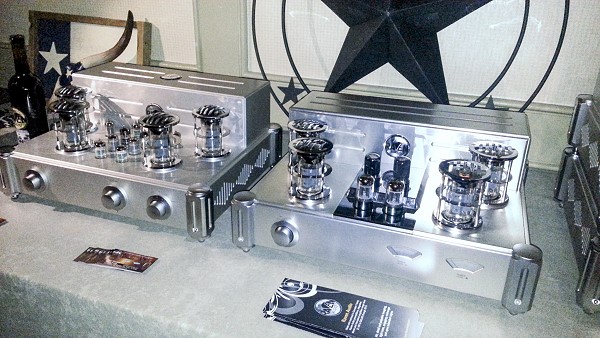
Here is a Raven product that has a very Retro appearance. At least, it might be interpreted as such at first glance. However, Dave Thomson, President of Raven Audio, told me, “Oh yeah….. and that old 1924 Sears Silvertone farm radio is not really a Raven product, but I know you meant that as a joke right!?! I just brought it as a bit of vacuum tube audio history. Hence the old 1924 New York Post ad in the frame on top of the Freed Eisemann radio that I snagged off of Ebay. Both are battery operated because most farms across the country did not have electricity in 1924. I love these old radio sets. They have something special about them. All hardwood cabinetry, heavy thick, and very raw basic technology at it’s earliest stage. A technology clearly reaching out from it’s roots, they were selling them before almost any of the kinks were worked out. They hummed, buzzed, barely had any clean audible sound whatsoever, and gripped the ears of rural bound families thoroughly until the broadcasts ended every single night that the chores were done. I am sure they also made chores go a bit faster if a good Amos n’ Andy show was coming on later too. How fun that all must have been~! Who really needed a picture anyway… until there was one that is. Then it all went downhill from there!”
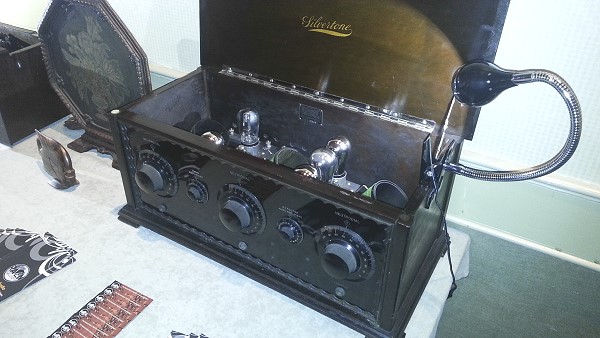
Headphones were everywhere as well. Here is a model with the incredibly complex driver array exposed. Amazing how much driver technology they can cram into a headphone earpiece. This headset is an Audeze.
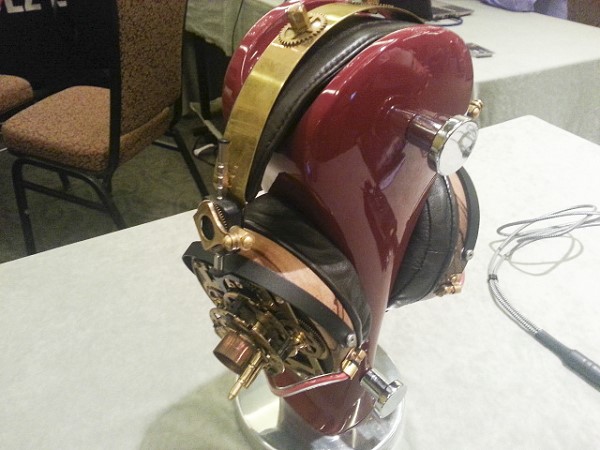
This is the first time I have seen significant numbers of tape decks being used as music sources to demonstrate amps and speakers. Shown below is a modified Technics, which cost the owner about $500, but then he had it modified and upgraded with such things as better output stages. You can buy this model of tape deck, all repaired and updated, for about $4,500.
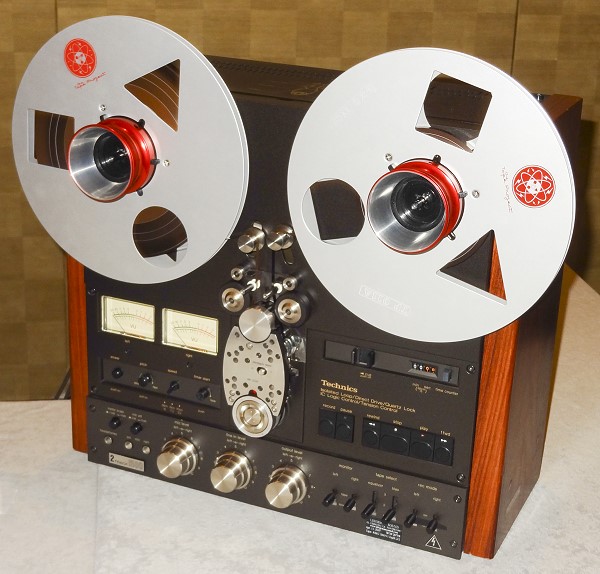
Both Ross Jones and I thought the deck, with a copy of a studio master playing, sounded fantastic. Apparently, you can “subscribe” to a series of master recordings and get them as they become available. The cost is $3,000 for 10 recordings. That’s a lot, but you are listening to a 2nd generation copy of the actual tape that was recorded in the studio, without any EQ, noise reduction, . . . anything . . . applied to the recording.

Here is an old Ampex that has been updated. It records four channels at the same time on 1/4″ tape at 15ips (inches per second). You can purchase copies of studio master tapes that were recorded at 15ips and play them at home. The sound is spectacular. Although this unit is probably worth about $40,000, you can also spend that kind of money on a CD player. Frankly this looks like a lot more fun. Unfortunately, the cost of studio master recordings is high, e.g., $400 for an album on tape. But, having a machine like this, that was actually used to record masters in the studio, would be ultra-cool.
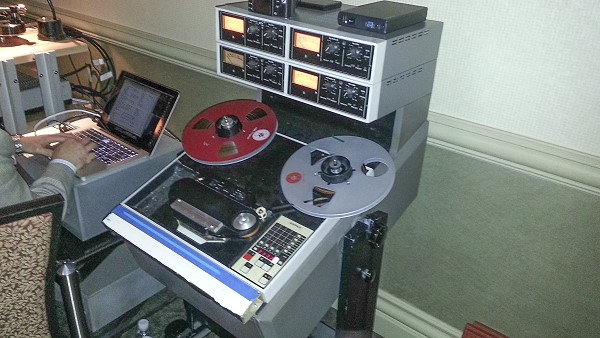
Now what would an Audio Show be without knock-your-socks-off cables? Here are some from Audio Reference Technology. Most are in the $2,000 – $5,000 range, but a pair of speaker cables called the SENSOR Haute Couture, 3 meters in length (about 10 feet), is almost $60,000.

Shown below is a close-up of the RCA interconnects in the first briefcase.

These cables are from Germany, and made by a company called JIB.
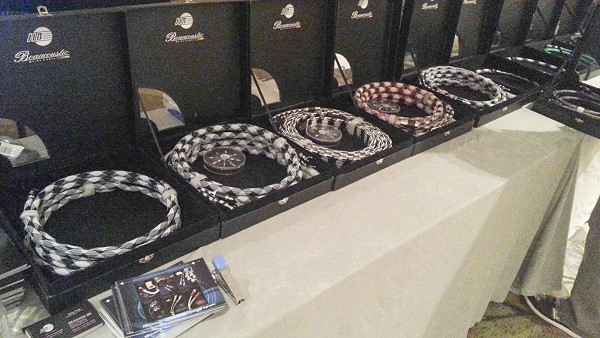
Woo Audio showed their tube products.
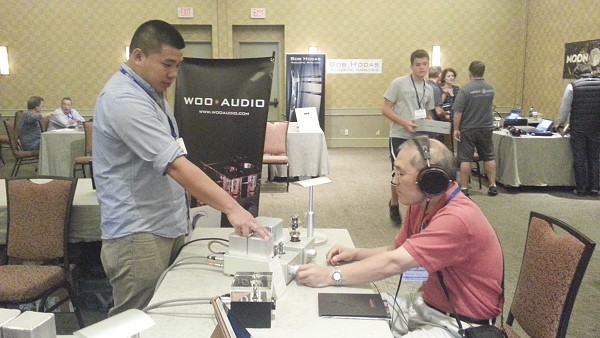
The photo below is their WA22 Headphone Amplifier, at $1,995.
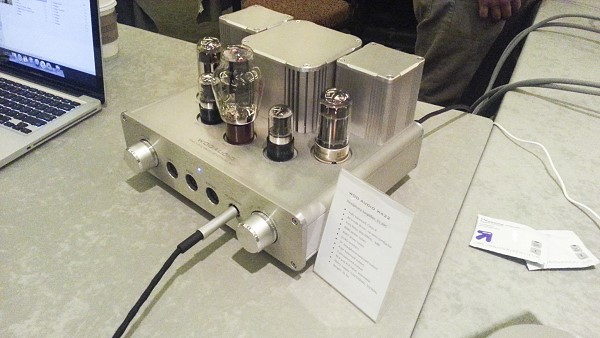
Another headphone amplifier, this one by Eddie Current, called the Balancing Act, because it has a fully balanced circuit. For headphones, this means that the ground for the left and right earphones have their own ground, rather than the ground being common to both earphones. This reduces sound for one earphone getting into the other earphone (crosstalk). Notice the extreme Retro design. This is getting to be very popular it seems.
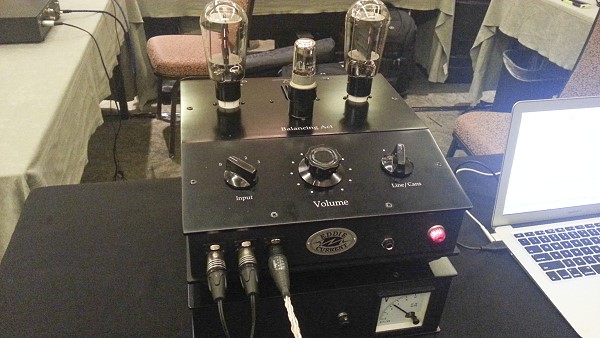
These speakers have the woofer, midrange, and tweeter in a concentric arrangement, which moves the sound more towards a point source alignment. They are about 1 foot square in size.
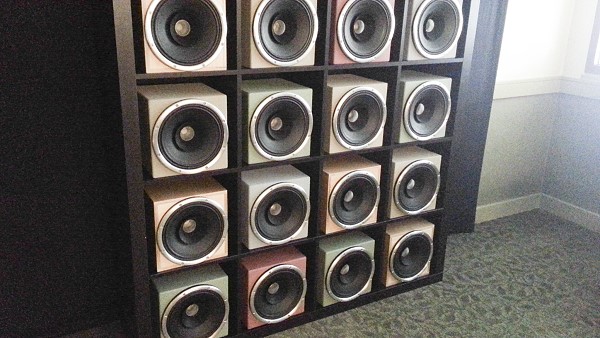
Vivid Giya G1 speakers, one of which is shown below, are manufactured in South Africa. They were being driven by VTL S-200 Balanced Stereo Signature power amplifiers ($15,00/pair). The G1’s are $40,000/pair, with the next model up costing $50,000/pair, and the top model is $65,000/pair. Obviously, from the shape of the enclosure, there isn’t a chance for standing waves to occur that would affect the sound.
David Rich, a Senior Editor at Secrets, had this to say about the Vivid: “The Vivid Audio G1 Giya is an AR-9 (1978) in a high tech box. The crossovers are similar to the frequencies as the AR-9. The design goal of the AR-9 was to reduce the interaction of the speaker with the rooms floor and back wall which produced constructive and destructive interference. This is called the Allison Room Boundary Effect (his AES paper can be found on the web) and are not to be confused with the intrinsic modal response of the room with which the speaker also interacts.
The front mounted lower midrange has no Allison interference with the floor or back wall since they occurred at lower frequencies than the 220 Hz crossover of the lower midrange.
The woofer was moved to the side of the speaker near the floor and side wall. The distances between the floor and sidewall are small, so boundary effects are now above 220 Hz. The problem is one woofer on the side will localize if crossed over at 220 Hz (most speakers with side-mounted woofers are crossed over at 80 Hz). To solve this problem, a woofer is placed on each side of the cabinet.
The problem with the AR-9, all the Allison’s, and the Vivid, is that they need to be against the wall to increase the frequency of interaction of the woofers to the back wall. In fact, it is said, the AR-9 was developed as a way to get around the Allison patent. If you pull them away from the wall, the interactions between the back wall and woofer reappear. The constructive interference can be dealt with using room EQ. The destructive interference produces a null that cannot be filled.
In the NYC 2013 show they were away from the wall.
The upper-midrange-tweeter crossover is high at 3.5 kHz. Not as high as the 7 kHz in the AR-9, but the drivers are still too far apart to prevent interference between the non-coincident drivers. Reviews of the AR-9 all pointed to imbalance when standing. The lower crossover and its steeper slopes of the Vivid will likely reduce this issue, but not eliminate it. The 4-way deployment should yield nice horizontal radiation patterns just like the AR-9, but note the waveguide on the dome midrange is missing on the Vivid.
The AR-9 was $1,500 in 1978 which would be $5,000 today. It was fully US-made but AR was transitioning driver production to Japan at that time. If they were still in business, it would be done in China. Still, given the number of drivers (two 12″, one 8″, one 1.5″ dome and one 0.75″ dome), plus its size and weight, $5,000 appears to be underpriced.
The AR-9 was ugly, with the width limited by the back to back 12″ drivers, and the on-wall requirement also held sales way down. The Vivid looks different, some would say better, but from an engineering front, we appear to be to have circled around for 35 years and not made fundamental breakthroughs in cone-based speakers.
Bob Carver now has the R&D funding from Dan Laufman to do the next generation Amazing speaker. I have no idea how it will end up, but I know he has lots of new fundamental ideas for the second decade of this century. Siegfried Linkwitz, whose crossover topology the Vivid uses, has also been advancing the art for 35 years, but has yet to attract someone who can take his prototypes to full scale production and distribution. As you can see from the photos on his website, Linkwitz probably also needs an industrial designer.”

A pair of 400 watt monoblocks, called the DMA-400 Reference, are one of Spectral’s latest iterations. The amplifiers, like other Spectral models, have a bandwidth in the MHz range, and are very fast, which translates to more audible detail.
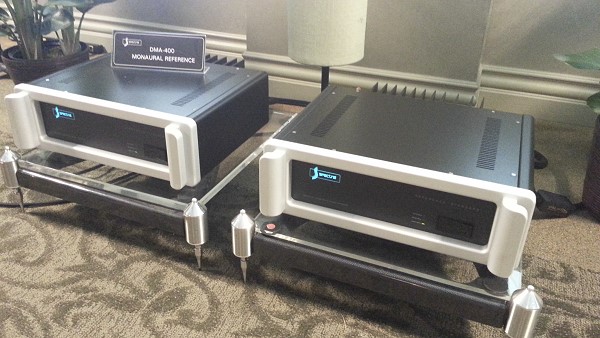
Eficion speakers struck me as very unusual, in that the stand for the smaller model has an inwardly tapering bottom half. I think this raises the center of gravity such that they shouldn’t be in a home with young children. Also, I consider the triangular flat front a possible reflection surface that could interfere with the sound. They were being driven by Plinius power amplifiers. The “folded” ribbon tweeter is being seen more and more in speaker designs.
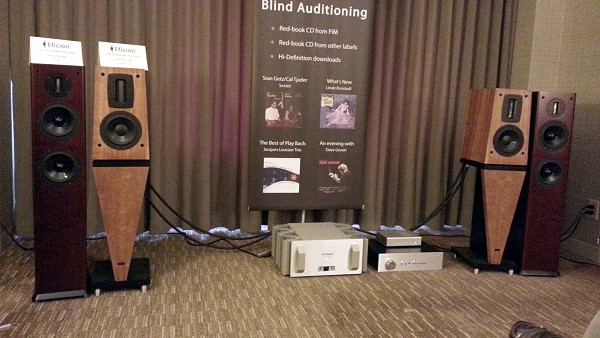
Here is a close-up of the Eficion’s. You can see the feet of the monitor-sized speaker separating it from the stand. And, the stand has feet too.
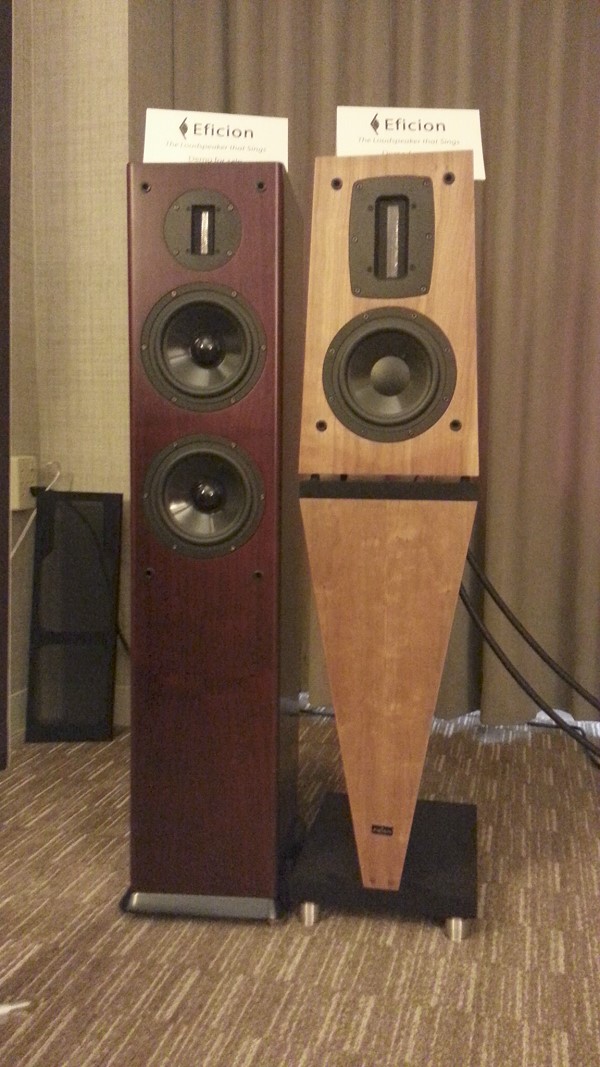
MartinLogan’s top tier full-range electrostatic speakers, the CLX Art, are shown in the photo below. In the past, ESL’s have been difficult loads due to the impedance at 20 kHz dropping to less than 1 ohm. However, MartinLogan’s rep in the exhibit room told me that they have redesigned the circuit so that even a modest receiver can drive them. The CLX Art has three stators, with two thin-film membranes, as opposed to the standard configuration of two stators and one membrane. This doubles the output, which is especially important for the deep bass. $24,595/pair.
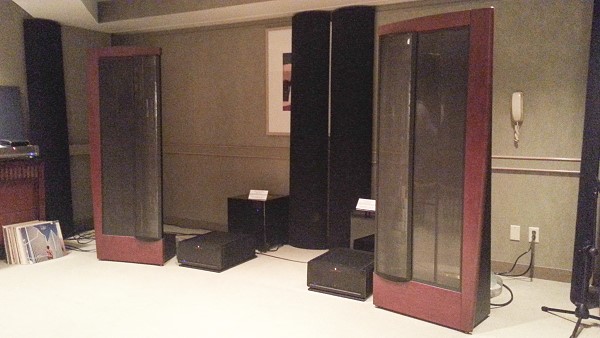
Over-the-top turntables were on display in many rooms. Here is one with illuminated control buttons, which assumes you will be listening in the dark.
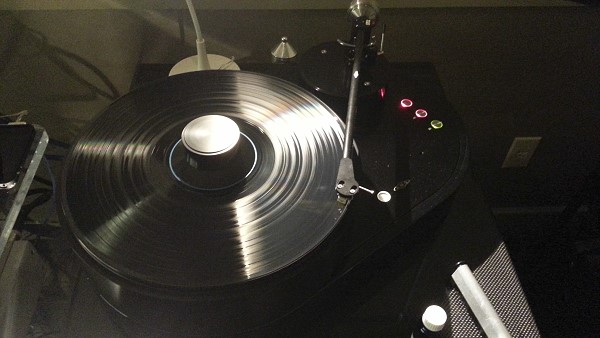
A close-up of the turntable arm shows the amount of dust that these devices attract due to static electricity buildup. That’s why record-cleaning machines are selling well.
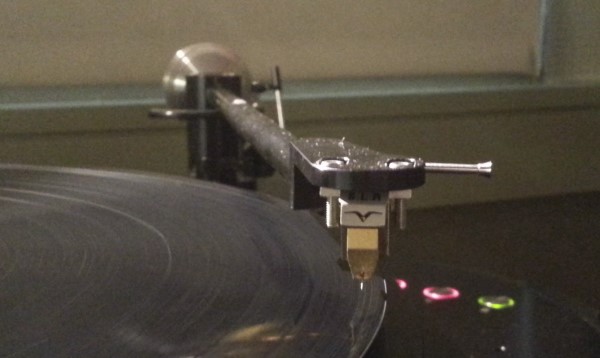
Surreal Sound’s Special Edition speaker, has six 10″ drivers, a Heil tweeter, an aluminum-magnesium midrange driver, and six 10″ woofers. The veneer is quarter-sawn, which is rare. $25,000 the pair. This speaker takes my “Most Beautiful Looks” award for the show. It sounded great too, but there were a lot of speakers at the show that sounded great. This one just happened to also be especially gorgeous to look at.
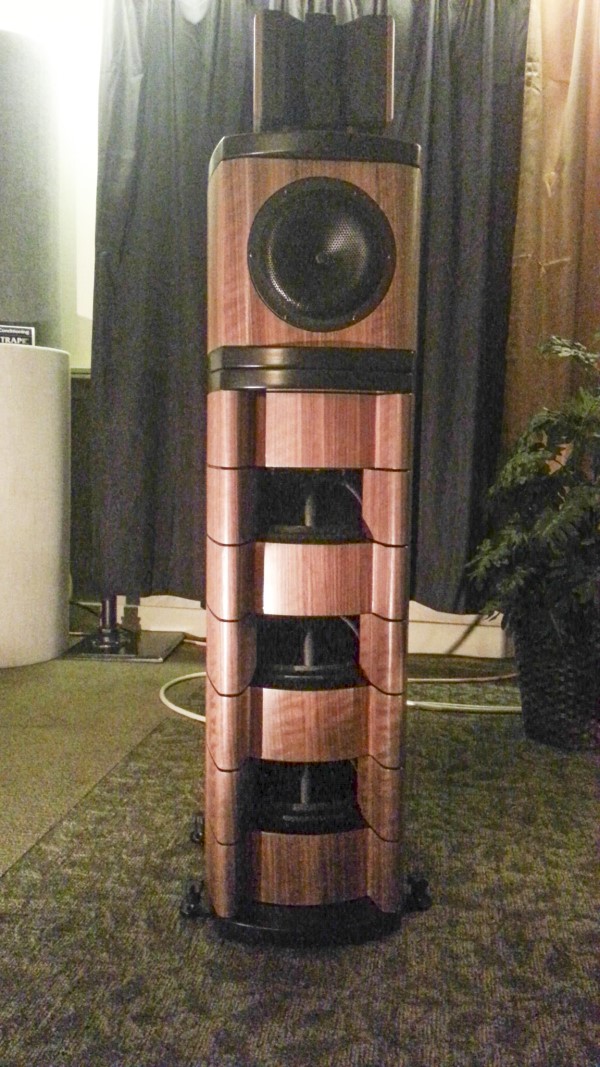
Legacy’s Aeris speakers ($16,900/pair) have a powered woofer, and some of the most beautiful veneer woodwork available. The triangular side panel opening has a blue light that can be turned on when you want special attention. The Legacy line is characterized by massive power and attack.
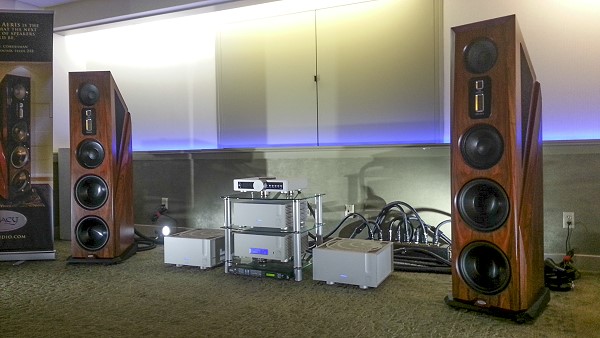
Here is a close-up of the ribbon drivers.

Due to the Aeris having a powered subwoofer, the rear panel has several connections, including five-way speaker binding posts, an RCA input for the subwoofer output from your processor, and an AC socket to power the subwoofer amplifier.
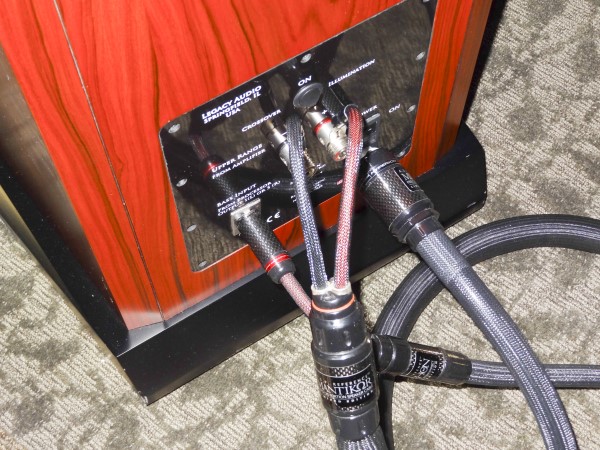
Shown below is a close-up of the amplifier setup driving the Legacy speakers in the photo above. They consist of the Ypsilon CDT-100 CD transport ($26,000), DAC-100 DAC ($29,000), PST-100 MKII tube preamplifier ($37,000), and Aelius monoblock power amplifiers ($36,000/pair).
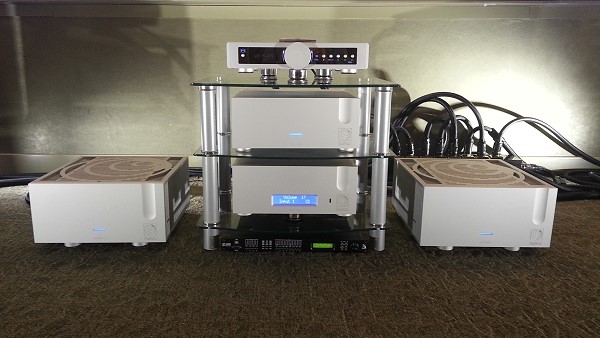
These Wilson Audio Duette-Series 2 monitor speakers are a new release, priced at $19,500/pair. I am assuming that the stands come with them, but I am not certain about that. They were amplified by an Ayre KX-5 preamp, followed by Ayre VX-5 monoblock power amplifiers. A turntable provided the signal. Cables were Shunyata. The sound was amazing for this size of speaker. Basso profundo. I kept looking for a subwoofer. I found it next door, but it was being used in a different system.
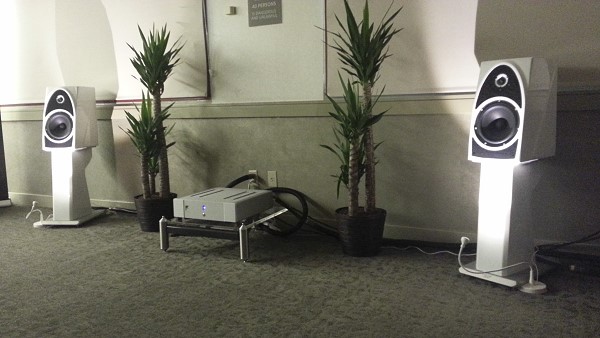
Whereas horn speakers used to be seen in numerous exhibit rooms at small shows, they seem to be diminishing in presence. Here is the Acapella, which seems to be at lots of shows. The sensitivity is 93 dB/w/m, so you don’t need much power to drive them, and they are very easy loads. About 15 – 30 watts per channel would be fine. They weigh about 300 pounds each, and are priced at $94,320/pair. If I had them, I would use a small pure Class A triode preamp and power amp (about 10 watts maximum output with a single 300B tube) to drive them. They sounded very smooth and effortless. Low spouse approval factor I suspect.

Here is a close-up of the speaker (tweeter) underneath the blue horn (midrange).
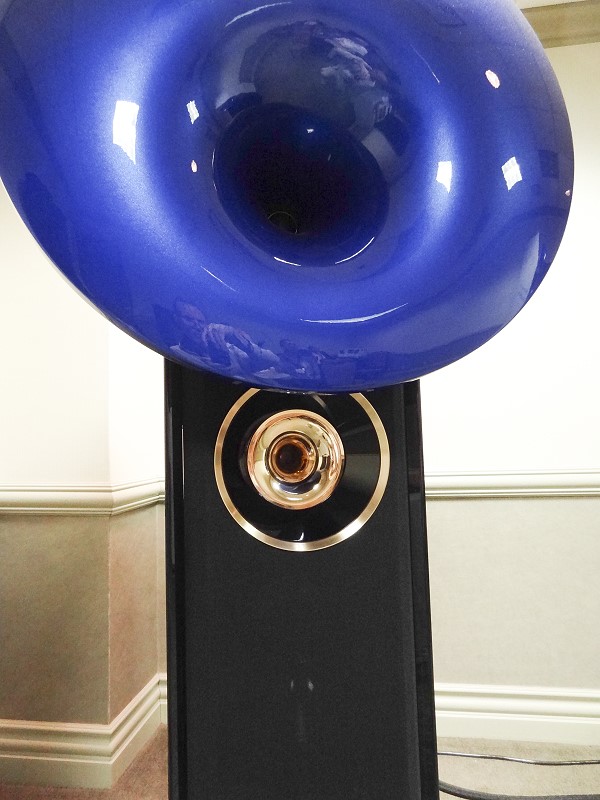
The electronics driving the Acapella horn speakers included Einstein tube and Acapella integrated amplifiers. The Acapella integrated amplifier is $99,400.
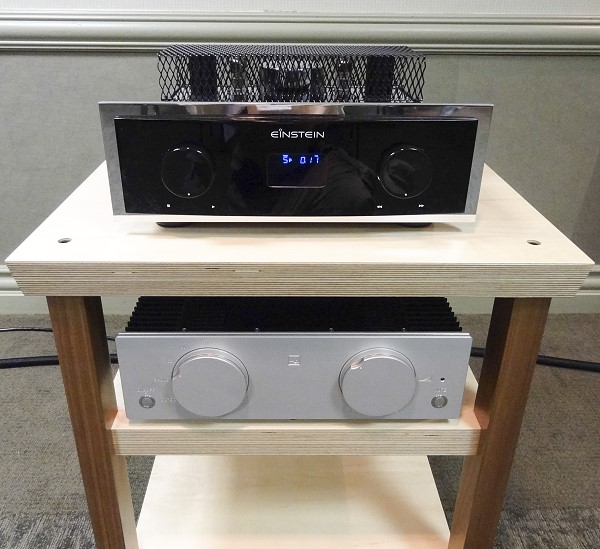
This is another example of the trend in headphones and headphone amplifiers. They both seem to be accelerating at the same speed, and quality. This headphone amplifier, called the Blue Hawaii, by HeadAmp, was driving a pair of electrostatic headphones. You talk about audio nirvana! Of course, one always has to deal with the sound coming from inside your head, and only one person can listen at any one time, but there is no question about the fidelity.
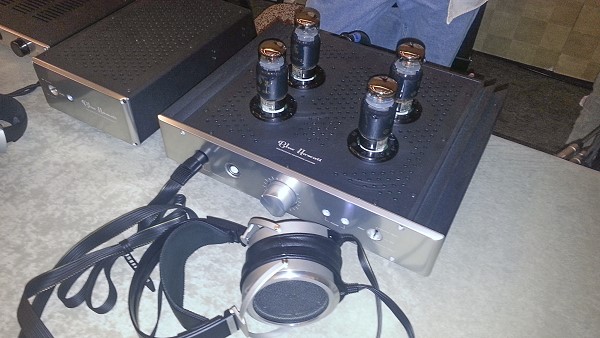
High resolution audio is not new, but having the guy who made the recordings show up with a booth to sell them is unusual. I purchased a recording of Chopin, Four Ballades, for $25. It was recorded – by him – at 24/96 PCM.
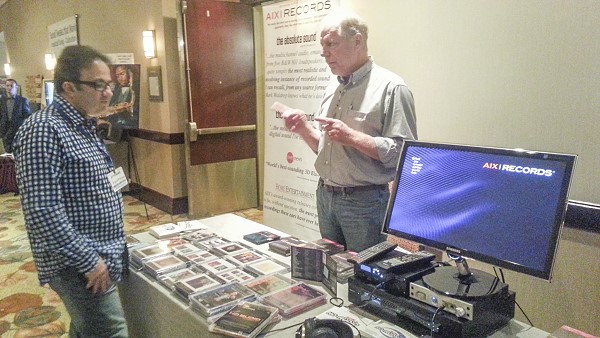
YG Acoustics claims that their speakers are tuned by hand to have as near a perfectly flat frequency response as is humanly possible. The enclosures are made of aluminum. Extremely expensive, terrific sound. Very transparent, with no part of the audio spectrum forward or attenuated.
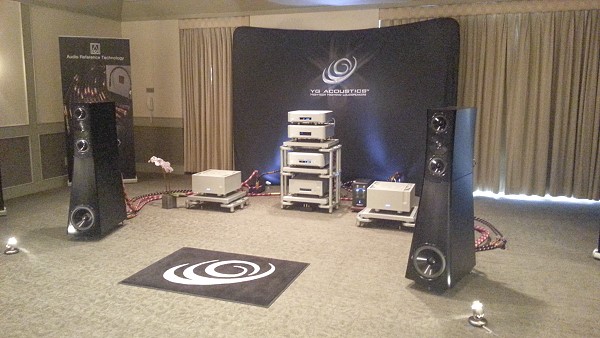
The YG Acoustics speakers were powered by Esoteric as shown above, and in the close-up, shown below.
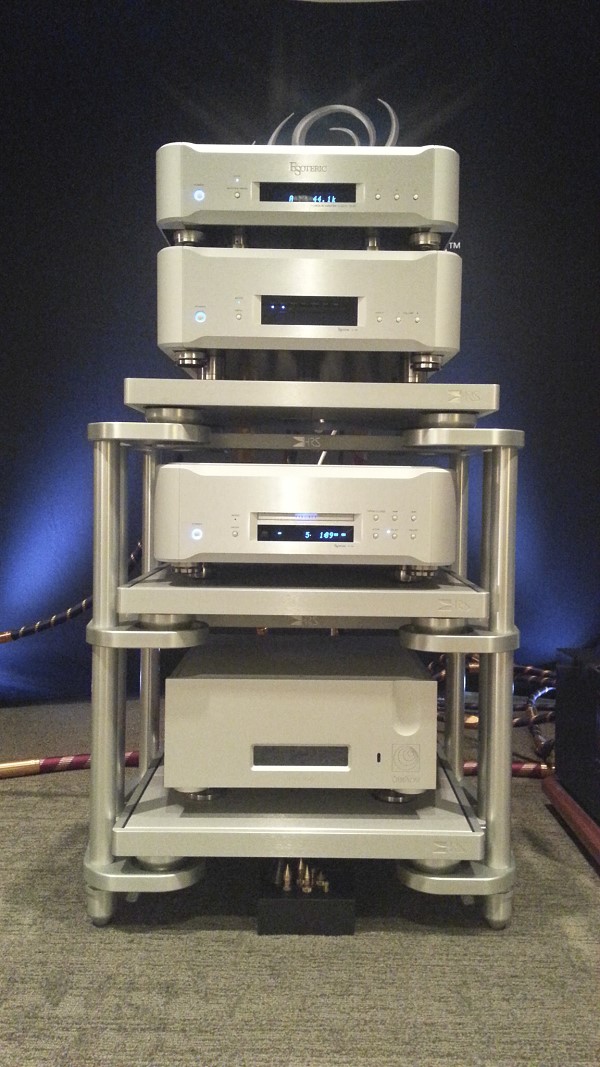
Von Schweikert showed their VR-100 XS “Universe” four-piece speaker “system”, which is priced at $140,000 for the pair. As you can see, they go nearly to the 8 foot ceiling, and I don’t know what they weigh, but I assume they arrive in four big boxes for each speaker, and they are assembled to end up with the complete unit. They are being driven here by Raven tube amplifiers.
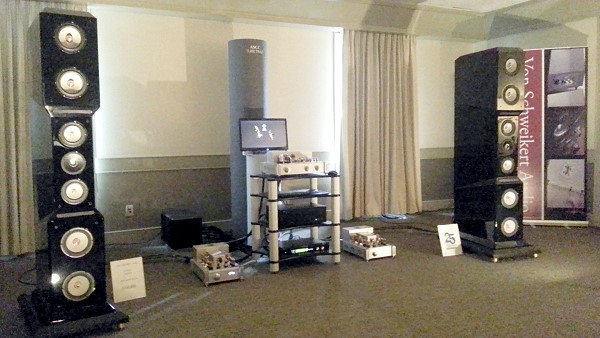
On day 3, they changed the Raven amplifier setup that was driving the VR-100 XS speakers.
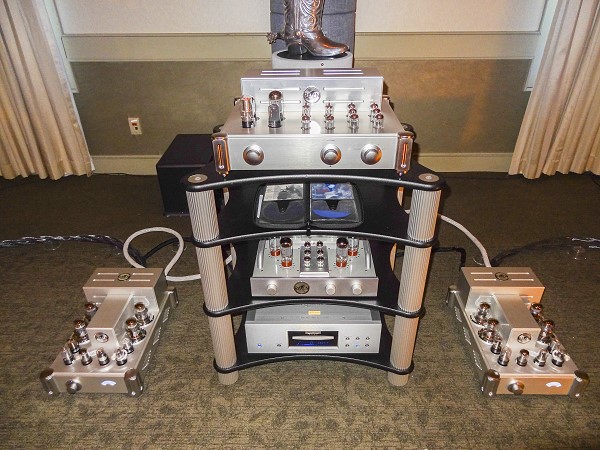
Zu Audio seems to be getting away from the wild enclosure colors of past years and going with the standard walnut, etc., finishes. Frankly, I never did want any lime green speakers. It doesn’t change the sound to make them spouse friendly either. And, the sound was good, as usual. But get a look at that LP sitting to the right of the turntable ! !
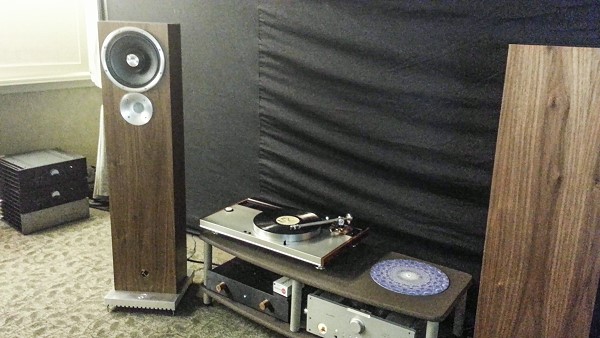
These new Sonus Faber monitor speakers are $6,500/pair, and they sound like it. Notice the wave guide for the tweeter, and then the sound passes between wires as a grille. One would think there would be diffraction effects with the thin wires, but I couldn’t hear anything but clean music.
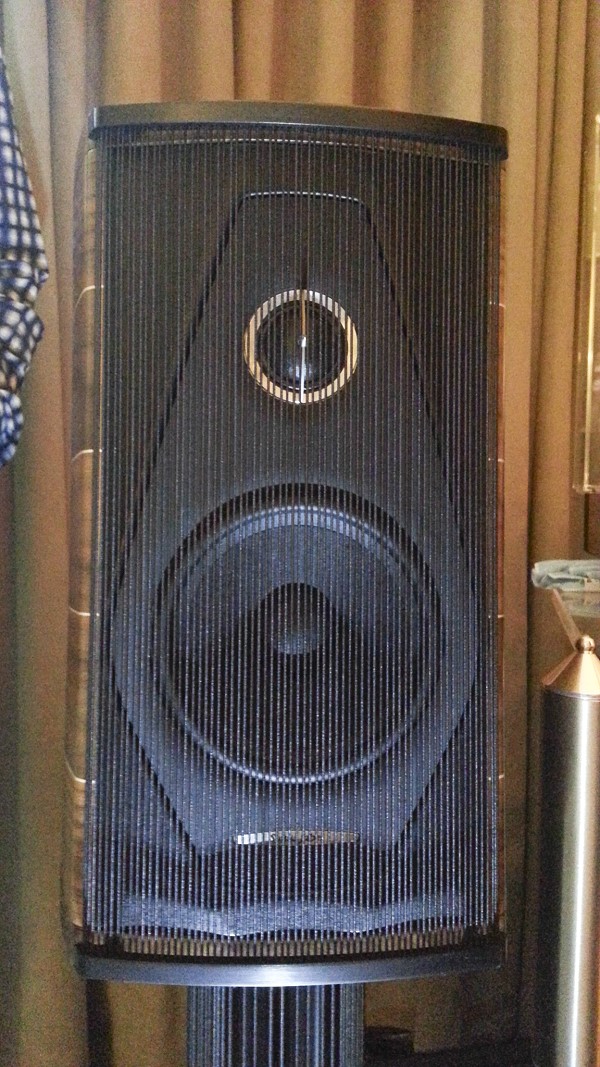
This little gadget, the ADE-24.1, from Margules Audio, does something I have been trying to think of a way of doing for years. It takes a stereo digital audio signal at line-level and eliminates the odd-ordered harmonics. It works best, obviously, when the signal contains a significant (audible) amount of these harmonics. Think mass market. So, if you have an inexpensive CD player or DVD player, with RCA stereo outputs, you place this unit between the player and the preamplifier. I heard it, and it works. All the glare and harshness found in some players was gone. The soundstage seemed to open up as well, and I don’t quite understand that, but the point is, it works, it works well, and it’s cheap ($275). I give it the “Most Unique Accessory” award for the show.
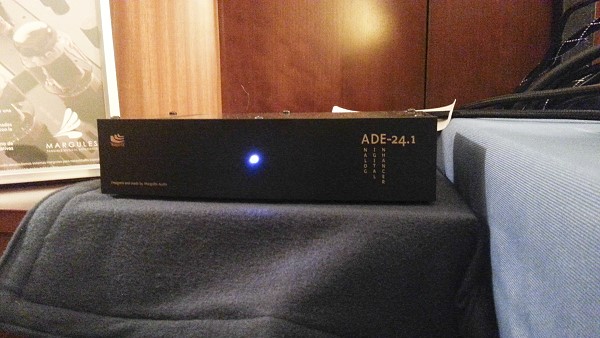
Another tape deck being used as a source to demo the entire audio system. I didn’t have a chance to ask what the brand was, but it appears definitely to be a studio recorder. Very nicely restored. To the right of the tape deck was a turntable. The guys in this exhibit were definitely analog all the way.
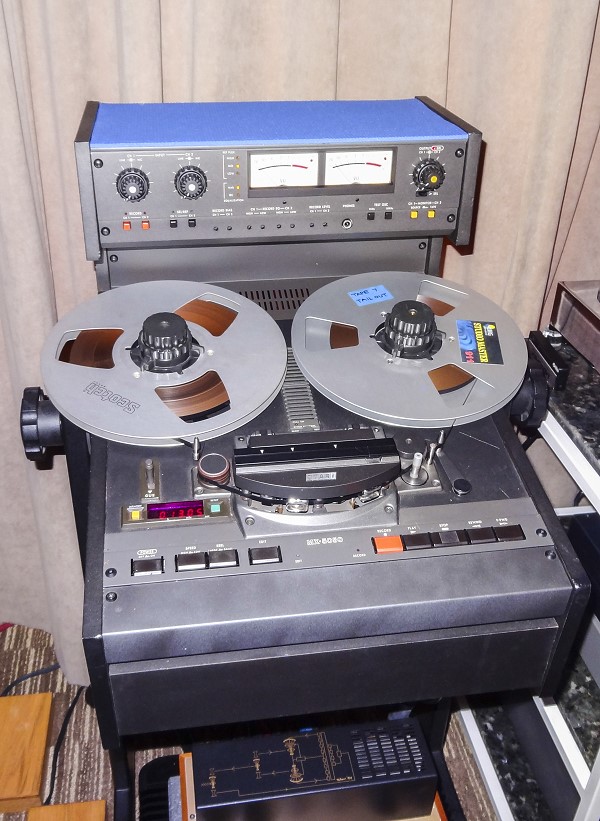
This setup consisted of an Ortofon MC Anna phono cartride, Tri-Planar MK VII tonearm, Merrill Williams R.E.A.L 101 turntable, Pass Laboratories XP-25 phonostage, Pass Laboratories XP-20 Linestage, Pass Laboratories X-250.5 power amplifier, and YG Acoustics Carmel speakers. It gets my “Best Sound at Show” award. YG make superb speakers with a very flat response, and combined with the smoothness of the Pass Labs components and vinyl, it just sounded like I could listen all day long without the slightest fatigue. Well done ! !
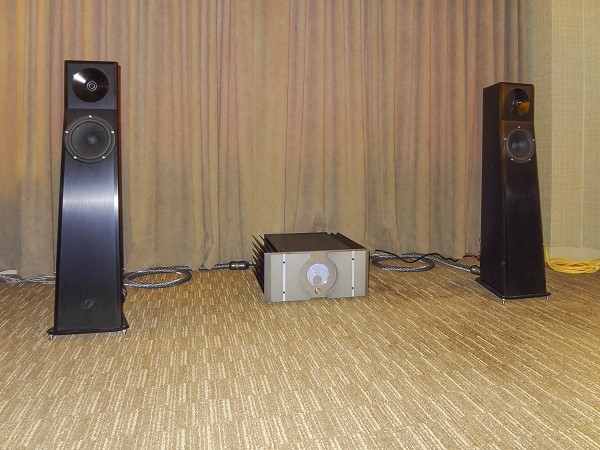
Remember the dissected “Audeze” headphones near the beginning of this report? Well, actually, that is an artistic rendition of a pair of headphones with all kinds of gears and other mechanical art that Audeze created for conventions. It’s not really a pair of headphones. Here is the actual Audeze, and in fact, their latest model, the LCD3, which is expected to retail for about $1,999. Two grand sounds like a lot for headphones, but they have managed to manufacture the thin film (the transducer) so that it is thinner than a human hair. The result is stunning detail. It’s powered by a Red Wine Audio headphone amplifier. This amp is not on their product list, but you can still order one if you want, and they will build it. I highly recommend the Red Wine with these headphones. A fantastic sound.
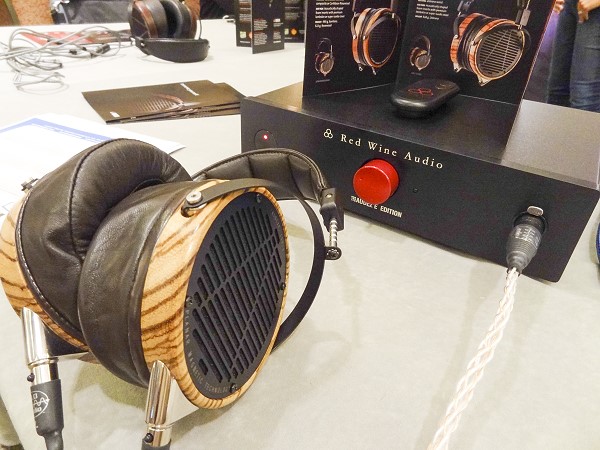
The Swiss always have excellent products, and these Klangwerk Ella speakers are no exception. The front baffle is made of an artificial granite material that is sonically dead (it does not vibrate in response to the sound). They are also very elegant, with a conservative appearance. $15,000/pair.
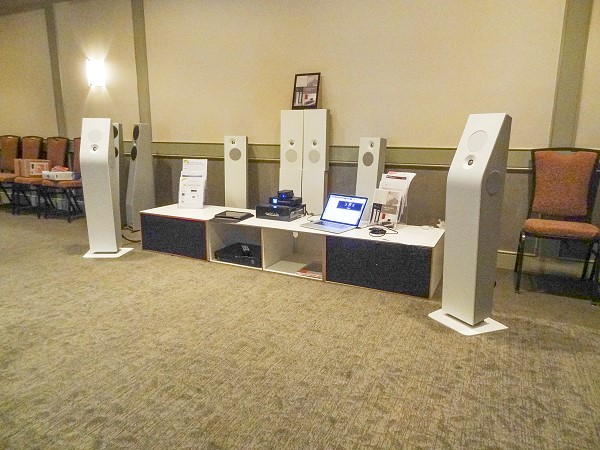
Salk Signature Sound showed some extraordinary speakers that had excellent sound, and unusual wood veneer (Pepperwood). This kind of look is for consumers who want everyone to ask them about their speakers when they visit. The veneer and numerous coats of varnish, with hand rubbed finishing in between each coat, is $4,000 just by itself. The base price of the SoundScape 8 speakers (the speakers with the large woofers) is $7,995/pair, and then add the $4,000 on top of that for this gorgeous and unique wood. All made in the USA.

A close-up of the Pepperwood finish is shown below.
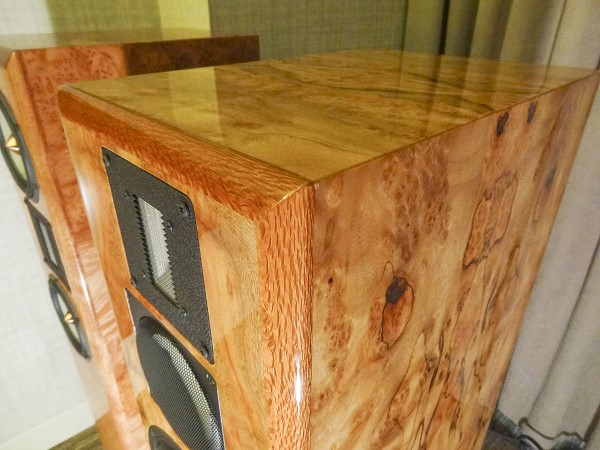
This unique sound diffusor has vertical tunnels in triangular shape. Each unit is hand-made and only costs about $250. It is 24″ x 24″ and about 4″ deep. I will try some of these out and do bench testing of the sound coming from the surface of the diffusor vs. a section of wall with no diffusor. This could be the start of something big, as I was shown some photos of actual installations that produced delight in their spouses. It gives a wall a modern art deco appearance.
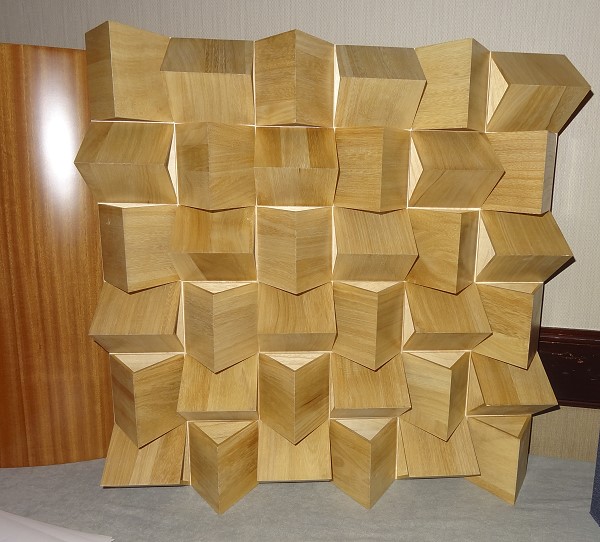
These Linn Audio Athenaeum horn speakers sounded marvelous. The sensitivity is up around 100 dB/w/m, so it only takes a few watts to drive them, in this case by Pass Labs power amplification.
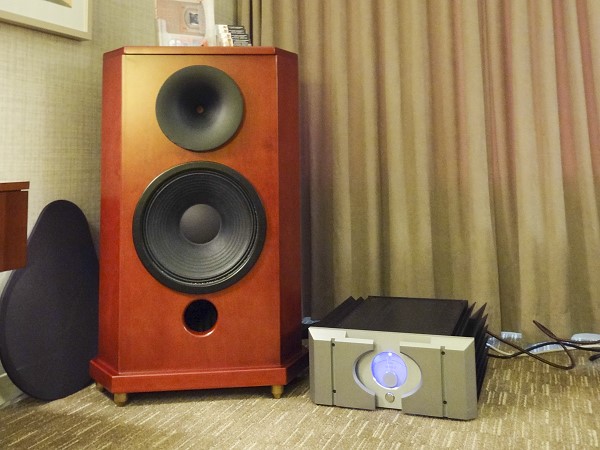
J.E. Johnson and Ross Jones


